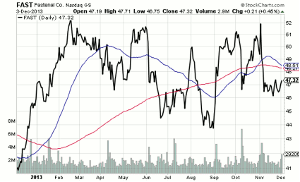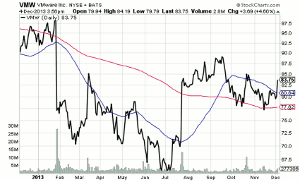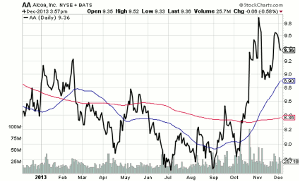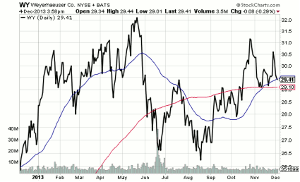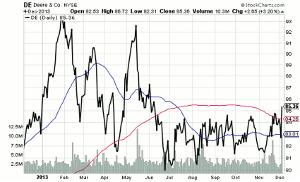Many of 2013's underperformers now seem likely to find their legs, and a few look as though they might well find some wings, writes Julian Close of MarketIntelligencecenter.
2013 is drawing to a close, and unless catastrophe strikes in its final weeks, both the Dow Jones Industrial Average (DJIA) (DIA) and the S&P 500 (SPX) (SPY) will end the year at or near record highs. Though the year has been marked by political turmoil in the US, stagnation in Europe, war in the Middle East, crisis in India, and a host of troubles in East Asia, stock prices have crept persistently and inexorably higher. Somewhat oddly, this bull market is not being supported by any surge in economic growth, nor does it seem to be causing one, which makes it appear almost hermetically disconnected from the real world. It must be allowed that the market is displaying some of the characteristics of a bubble.
Before you head for the hills, however, consider that the lackluster economy is actually the strongest argument against the bubble hypothesis. America is still taking up the slack in its economy created by the highly destructive crash of 2008, and it will be doing so for some time. Consumers, who were prone to wild fits of optimism in the last economic cycle, have been chastened and continue to spend carefully out of necessity. There was real consolidation and scaling back in wake of the crash, and although this caused a second wave of economic damage, it was necessary, and it is over now; things have been moving in the right direction since early 2011. As a result, what gains the economy is making are real gains, and though growth is slow, it is sustainable. Slow growth is likely to continue in 2014, which is not to say that the year won't have its share of scares and rough patches. While many companies have earned record profits in 2013, others are still in recovery mode. Expect a steady trickle of these recoveries as the year goes on. Many of 2013's underperformers now seem likely to find their legs, and a few look as though they might well find some wings. There's enough money in play to create many big winners, but not enough to sustain continued across-the-board price increases.
All of which means, of course, that 2014 will be a good year to be a good stock picker.
NEXT PAGE: 3 Stocks Poised for a Rebound
|pagebreak|Fastenal (FAST)
At close of 2012, Fastenal's stock was trading at $46.07 on an adjusted basis, and despite jogging in place for most of the year, it has now risen by one entire dollar. Fastenal's primary business is selling threaded fasteners, (yep, screws and nuts), but they sell an absolutely enormous array of stuff, most of which is designed to make stuff, hold stuff together, or carry stuff from one place to another. Fastenal stores can sell you any of 6,000 office products as well as 23,000 janitorial supplies.
Fastenal doesn't make the items it sells, but acquires them through a highly diverse supply chain in which no single company is allowed to supply more than 5% of Fastenal's products. Profit margins in this kind of business tend to be low, but Fastenal has been cutting costs successfully, and that could make all the difference. As consumers start to spend more loosely, the company should benefit greatly from its strong market position and low overhead. Twelve months from now, expect FAST to be trading higher by 15% to 20%.
FAST Daily Chart
VMware (VMW)
VMware is a cloud computing company in which EMC (EMC) owns controlling interest. This has been a transitional year for EMC and some of the Street's negativity toward the parent appears to have rubbed off on the child. VMW stock has fallen by nearly 20% this year, despite revenue which has been rising steadily since 2009 and earnings which are on track to rise by an astonishing 97% this year.
Any time you see earnings and revenue headed in one direction and a stock price headed in another, it is worth asking why. In this case, the concern seems to be coming from the stagnation in Europe and the US government's reduced IT expenditures. While these are problems, neither is likely to prevent VMware from growing as more and more companies seek to take advantage of virtualization, a technology that allows companies to run their own software on VMware's powerful mainframes.
While the company does face strong competition from Microsoft (MSFT), users can only take advantage of Microsoft's virtualization when they use Microsoft software, and few companies wish to be so limited. Nothing is ever certain when it comes to rapidly changing technologies, but VMware's price looks far too low to me, just due to the facts that are already known. Sometimes the Street misses the real value of stocks when they are majority-owned by another company, and this looks like one of those times.
VMW Daily Chart
Alcoa (AA)
Alcoa is the world's largest supplier of aluminum and alumina, which is a material used to make aluminum. Due to global overproduction of aluminum, Alcoa has had a dreary decade, and AA stock has lost more than 75% of its value. The problem was compounded by the 2008 crash, which dramatically lowered world demand. Despite the slow economic recovery, demand is recovering sluggishly, and the price of aluminum has lagged behind other metals. The reason for this seems to be that up until now, the recovery has not been strong enough to revive sales of durable goods, but that day is probably not far off.
NEXT PAGE: 2 More Stocks Poised for a Rebound
|pagebreak|In addition to the very high likelihood of increasing demand, consolidation within the aluminum industry has, at last, put the brakes on overproduction, which means that the price of aluminum should rally at last. After years of cutting costs to offset falling aluminum prices, Alcoa could emerge stronger than ever before.
AA Daily Chart
Weyerhaeuser (WY)
On the recovery curve, Weyerhaeuser is at much the same point as Alcoa. Gains in the financial, retail and technology sectors all promise an eventual return to pre-crash norms, but consumers and businesses alike are still wary when it comes to making large dollar purchases. Weyerhaeuser's business, of course, is wood, and the company is sensitive to the global price of wood pulp, despite having numerous sources of revenue, including the selling of gas and oil rights on its more than six million acres of forest land. As a result of the global glut caused by the crash, Weyerhaeuser now brings in only about a third of its pre-crash revenue, and WY stock trades for about a third of what it did in 2007.
It isn't new refrigerator sales that are needed to put Weyerhaeuser back on top, but new home sales. 70% of the wood sold by Weyerhaeuser is used in the construction industry, to which the company's fortunes have long been tied. Fortunately, economists are expecting housing starts to go up by 20% in both 2013 and 214, leading to a jump in Weyerhaeuser's annual earnings per share of 62%. The uptick in housing starts should be one more indicator that yes, the recovery is real, and yes, it will eventually include even dinosaur, old-economy commodity companies. Since both Weyerhaeuser and Alcoa are plays on maturing economic growth, all but the most highly diverse investors should avoid buying WY and AA stocks at the same time.
WY Daily Chart
Deere (DE)
Deere is yet another solid company that spent 2013 as a bridesmaid, not a bride. Like Alcoa and Weyerhaeuser, Deere thrives when the global economy allows as many people as possible to make large ticket purchases. Unlike those, Deere's success is not tied to the price of any one commodity, but to the needs of the industries it serves, agriculture and construction. Farm profits have been high in recent years, and as a result, Deer's sales and its profits were quick to recover from the 2008 crash. In fact, the company's fiscal 2013 earnings per share of $9.09 represents an increase of 94% from its earnings per share in fiscal 2008.
DE Daily Chart
So why is DE stock lagging so badly? Why the comical P/E ratio of 9.4? The answer, unfortunately, is that changing global conditions have caused food production to expand too rapidly, and economists almost universally foresee 2014 as a period of falling food prices, falling farm profitability, and falling demand for Deere's agricultural equipment. That might be a catastrophe if Deere sold nothing else, but the decline will likely be offset by increasing demand for Deere's construction equipment, hence, Deere's revenue will likely contract only slightly in 2014 before beginning to rise again in 2015. The valuation here shouts “buy,” and in the bigger picture, the macro-economic conditions agree.
By Julian Close of MarketIntelligencecenter

